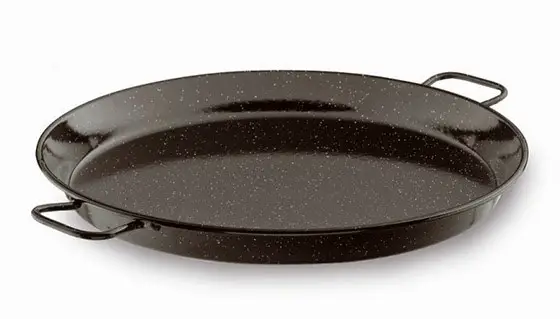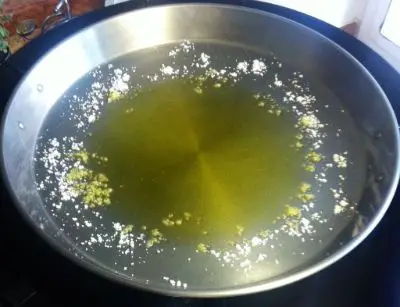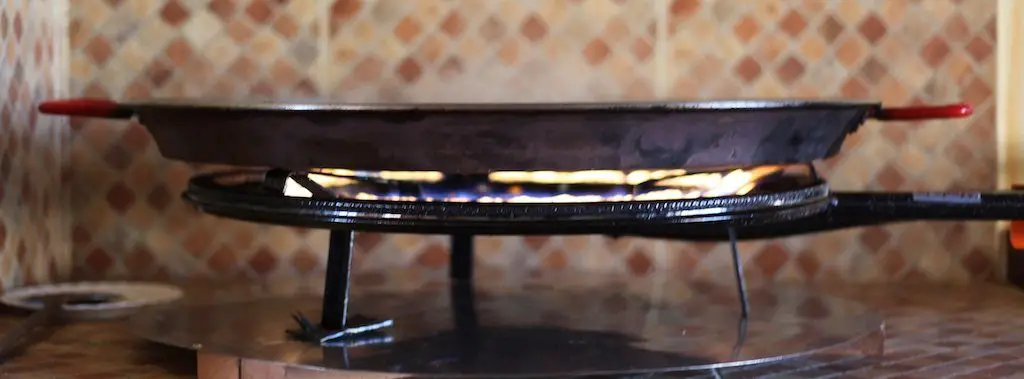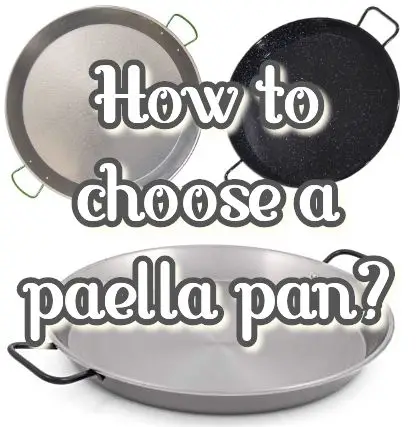Traditional paella pan is what you may need to nail your paella cooking. But, what is a paella pan? How to use them? How can I take care of a paella pan? No worries, you are at the right place.
What is a paella pan?
The container in which the paella is cooked is called paella or paella pan. In the Valencian language, the word paella means frying pan; and it was the frying pan that gave the name to this typical Valencian recipe.

In Valencia today the word paella is still used to refer to the frying pan, while in most of the Spanish territory it is called paellera. Both names are valid.
I will speak about Paella or paellera indistinctly for the recipient and paellero as the support and burner that is used to make the paella.
In this post, we are going to talk about the types of paella pan that are usually used in Valencia to make an excellent paella.
How to Choose a Paella Pan?
Do you want to cook paella but you don’t dare because you don’t know how to choose a paella pan? Which size would be enough to make rice for everyone? Is the paella pan I have good or will I have to buy another one? Will I be able to make it with the paella pan I have?
I will help you to find the best paella pan for your needs
How to use a paella pan?
If you wonder how to use a paella pan you are not alone. We have to admit that this pan is a compact kitchen gadget that can suffer a lot, but it can’t stand everything. There are things that should not be made with a paella.
This mechanical prodigy has physical limits that by pure ignorance and ignorance are exceeded too many times.
Can you cook paella in a cast iron pan?
The traditional paellas are still cast iron and steel. In all these years it has have accumulated experience and developed technology at the highest level, but the traditional paellas are still cast iron and steel.
It is true that there are other ceramic containers, non-stick, glazed, for induction or glass-ceramic, with the appearance of paella, but they are not, nor are we very interested in authentic lovers.
Much of the magic of paella is found in its armored steel soul, a material capable of transmitting all the power of fire, with its bravery and measure at par.
What shouldn’t we do with paella?
Never and under no circumstances should a huge quantity of wood be set on fire or all the rings of the burner be lit to the maximum with the empty container. Because it will immediately become deformed and will no longer return to its original state. The same is advised with other types of heating.

The larger the diameter of the paella, the more it will tend to twist if it is put on fire without following some basic recommendations:
The first and main one: absolute control of the fire, especially when starting to cook the paella. When we sauté we only have oil in the center and the rest of the paella reaches very high temperatures. At that time the risk of deformation is high.
There is a belief that spreading salt around helps prevent it from bulging. It is absolutely false.
If the paella is used for other purposes such as frying eggs, peppers, sardines or onions. This is very common in typical Valencian lunches. Keep in mind that the best result will be obtained with medium heat; you can heat the oil well, but unless you cover the whole base of the paella, it should be done on a moderate heat.
It is fundamental to level the Paella before starting the heating. Under no circumstances should the empty container be placed on the fire. If the intention is to use the paella as an iron, previously it has to be lightly spread with oil inside and outside to better support the fire.
Archimedes said: “Give me a point of support and I will move the world” In the case of the paella it would be… Give me good support and I will resist better. The trivets or irons on which the Paella has to be sustained must provide it with a stable base.
If you cook with firewood you have to avoid concrete blocks or bricks to fix them, because instability and deformation are guaranteed.
If we are going to use gas we must have a diffuser of the same proportions that the Paella that we are going to use.

Can you use a paella pan in the oven?
There are lovers of finishing off the paella in the oven. Besides, there is a rice dish made in the oven called “arroz al horno“. If you are among them, you should know it is very likely to be deformed, because the bottom curved outward is its only point of support.
The paella is a container that is used with a weekly frequency in the Valencian houses, basically on Sunday. Once finished using, it should be washed and dried perfectly (never outdoors) and before storing, spread with oil to avoid rust.
This simple explanation should accompany all paellas that are given to a non-expert. The vast majority of them end up in the garbage because the laymen do not know what to do with them when they rust.
How to care for paella pan?
How to season a paella pan
Seasoning a new paella pan in very important. Although the current paellas are much better built than the old ones, it is advisable to keep basic and generic care
- The first thing you have to do is remove the sticker from the paella.
- Then, turn on your paella pan or gas cooker and place the paella.
- Add water up to the height of the rivets and let it boil to check the thermal stability and always with the paella supported on a stable and uniform surface
- Once the water is boiling, let it boil for a few minutes (about 10), until the water is no longer clear (a sign that the wax is dissolving in the water).
- Then discard the boiling water (with care to burn you) and scrub the paella, with warm water and soap and scrubbing hard enough to remove any remaining wax.
- Scrub both inside and outside of the paella.
- Once it has been scrubbed, rinse it with water and dry it either with kitchen paper or with a cloth. But it has to be dry.
Once cleand and dry, rub a small amount of vegetable oil on the pan to prevent rust. That’s recommendable only in the case of iron or steel paella pan.
Never heat the paella if it is empty. It is necessary to avoid completely the thermal shocks in the paella that could lead to permanent deformation of the same one, this is more important the greater the size of the paella. Examples of thermal shock would be adding cold water in an empty paella that has been previously heated.
How to care for polished steel paella pans
Polished steel paellas require special care to keep them in the best conditions and avoid oxidation. Before the first use, it must be thoroughly washed to remove the manufacturer’s special anti-rust layer. This can be done with hot water and soap.
Although it is better to heat some water in the pan with a splash of vinegar, simmer for 10 minutes or so, and then rinse. Be sure to dry the paella well and then cover the inside with a little vegetable oil. This seals the surface to prevent oxidation.
How to clean steel paella pans?
This type of paella should be cleaned by hand (they are not dishwasher safe). Do not air dry. As this is a product made of steel to keep them in perfect condition once dried should be coated with a thin layer of vegetable oil to prevent oxidation and should be stored in a cool and dry until next use.
I recommend that you keep it wrapped in paper, inside a plastic bag.
By the way, if you forget to close the paella and it oxidizes before its next use, don’t worry. Simply remove the rust with a ball of steel wool (it comes off easily) before use.
When cooking with polished steel paellas, do not leave the paella empty over the direct fire for more than a few seconds. The metal could overheat, which could cause a dark stain on that part of the paella.
How to care for steel enamel paella pans
Made of steel, they are coated with a black and white mottled enamel, so oxidation will not be a problem. They are easy to clean and store and do not need oil after use. The enamel coating facilitates the cleaning and maintenance of the paella.
How to clean steel enamel paella pans?
Enamelled steel paella can be cleaned in a dishwasher but will last longer if cleaned by hand. The easiest way to do this is to fill the dirty paella in half with water and let it rest for a couple of hours or all night.
Then pour in the water and use a soft sponge and dish soap to clean the residue. It will clean up easily. We recommend this glazed paella instead of the polished steel paella pan, if you are not going to use it regularly.
How to care for Stainless Steel paella pan
This type of paella is almost as maintenance-free as steel enamel paella. They do not rust and do not require any special cleaning. When cleaning them, avoid the use of steel pads to avoid scratches. Soaking the paella in water will make cleaning easier.
How to clean stainless steel paella pan?
Stainless steel paella can be cleaned in a dishwasher but will last longer if cleaned by hand. The easiest way to do this is to fill the dirty paella in half with water and let it rest for a couple of hours or all night. Then pour in the water and use a soft sponge and dish soap to clean the residue. It will clean up easily.
Stainless steel paellas heat up and cool very quickly. This is good for making paella, but keep in mind that you should not leave an empty stainless steel paella on direct fire. If an empty (or almost empty) paella is left on high heat for a long time, the paella may become discolored or deformed. But as long as there is broth or food in the paella that absorbs the heat there are no problems.
Burner/cooker Maintenance Tips
Cleaning should be carried out when the appliance is cold. It is recommended to use a cloth dampened with soapy water, carefully to avoid water entering through the outlets of the gas. It is then dried and stored in a clean, dry place protected from dust. The enamel layer that covers the paella pan facilitates maintenance.
If only the inner ring is used, it is recommended to protect the outer ring to avoid obstructions.
Maintenance tips earthenware pots
- The clay pots must be taken care of the blows, which break them easily.
- Before using the first time, keep the casserole in warm water for 5 minutes.
- Always cook at low heat for continuous and gradual transmission of heat.
- When cooking, always keep the broth in the bottom.
- Do not subject to sudden changes in temperature.
Tips for the maintenance of enameled cast iron paella pans
Its vitrified enamel layer avoids having to cure the plate and facilitates its maintenance. Use a soft sponge and dishwashing soap to clean the residue. It will clean easily.
Wash it with soap and water before first use to remove possible dirt from the manufacturing process.

